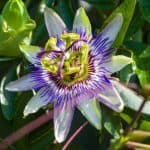Last updated on March 6th, 2022
Our site is reader supported, this means we may earn a small commission from Amazon and other affiliates when you buy through links on our site.
If you are looking for smaller growing clematis for shade in your garden, rest assured there are plenty of options at your disposal. Even though most clematis plants require full sun, there are plenty of dwarf clematis varieties that love the shade. Given the popularity of clematis in regular homes, new hybrids and other varieties have made their way onto the marketplace that allows people to plant in any location.
Below are some of the best shade-loving clematis for pots and for anywhere else you want to plant them.
The Top 6 Dwarf Clematis for Shade
1. Clematis ‘Taiga’
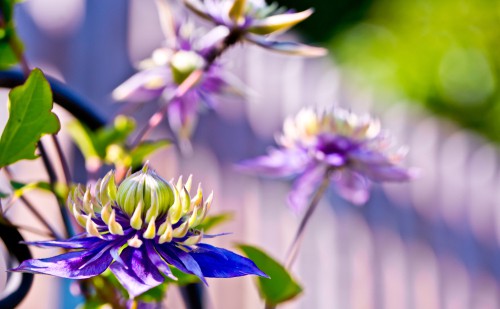
This clematis works very well on its own given the stunning purple flowers that are produced. These flowers have multiple layers to them with deep, double purple shades and yellow-green tips. With this variety, it will grow moderately in a climbing habitat between the summer and autumn and is well-suited to colder areas.
It will do well with partial sunlight so if you have an area where there is shade for half of the day or more or even dappled shade, you can plant it in that area but make sure to add water and fertiliser regularly. Watering should take place on a weekly basis until the plant is established itself as with most clematis, usually until after the first season.
Fertilising should take place twice a year but not when it is flowering. When it comes to pruning you should shape your plant, if necessary, at the beginning of spring before the flowers have bloomed. In order to help keep the soil cooler, you can add mulch around the base but not directly up against the base. This clematis belongs to clematis group 3.
2. Clematis ‘Samaritan Jo’
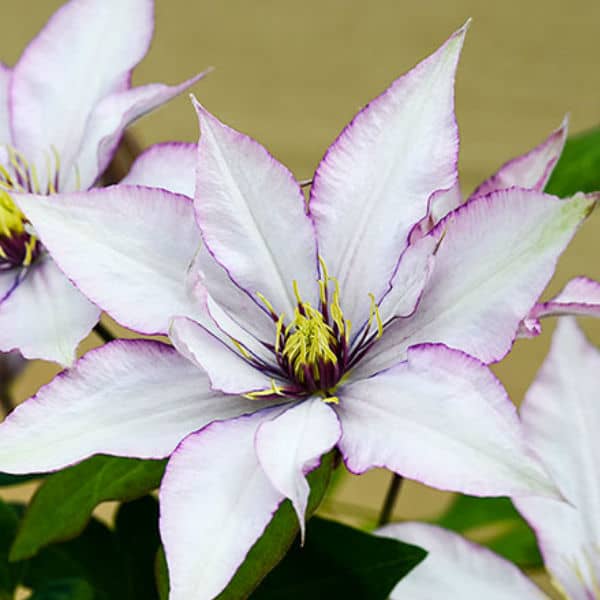
This variety is perfect for patio planting and simply looks beautiful. It is a compact variety that has layered and pointed petals, each of which takes on a silvery-white shade with a rich purple edging. The centre brings with it a crown of dark purple tipped with bright yellow.
It will meander over any trellis or fence you have if you give it something to climb up. This variety attracts butterflies, is perfect for pollinators, has a long flowering cycle and will fare quite well in containers.
With this particular variety, the white flowers accented with purple will thrive first in early summer or midsummer and second in early autumn so you can enjoy the blooming cycle twice a year. This performs best when you prune it after the first flowering just to cut off any dead material. You should tie it to a trellis or other structure to climb up, however, do not tie it so tightly that the growth gets damaged trying to move.
No products found.
3. Clematis ‘Carnaby’
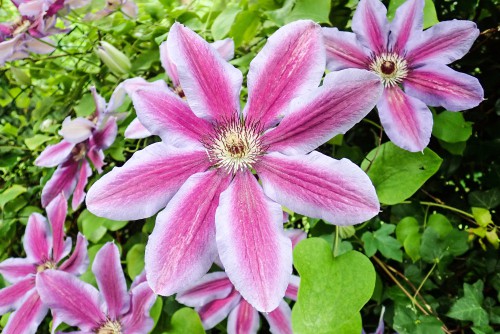
The clematis Carnaby is a more compact bloomer that provides flowers in the spring and the early summer and then provides a follow-up flush of flowers at the end of summer or the beginning of autumn. This variety offers deep pink flowers with deep pink stripes down the centre known as bars. They can be prone to fungal diseases early on so you will need to put in a small bit of care initially to protect them, however, once they are fully established they are relatively trouble-free.
It is important to install a trellis or other support structure for your Carnaby clematis to climb. This is a very compact clematis so it will only reach around 2m tall and this means you won’t need a large structure. Even small trellis or plastic netting strung across your fence or wall will be adequate.
This variety grows best when you provide it with weekly waterings and feed in the spring. You don’t want to fertilise this variety when the plant is in bloom because that will shorten the flowering span. You should prune it lightly, removing any dead vines as you see them and when the first set of blooms begin to fade, you can prune or deadhead again to help improve the second flush of flowers. This clematis belongs to pruning group 2 and you can read about it here.
4. Clematis ‘Angelique’
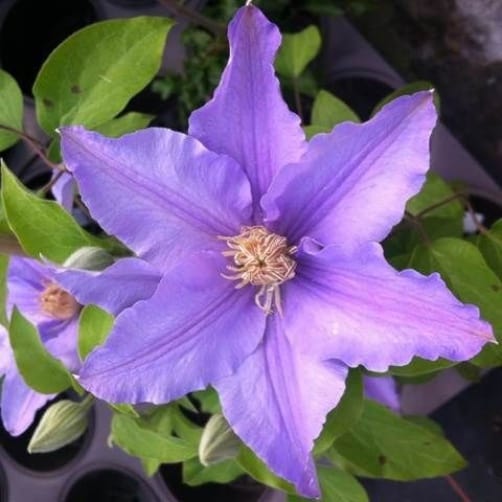
This variety has pale, silvery lilac coloured flowers that take on a star shape. The petals have waving margins and come to a point. But that’s not all that draws the eye. The blooms are made even prettier by the crown of stamens. This particular variety is incredibly compact and is a free-flowering climber that will do perfectly well in shaded areas.
You should prune it hard after the flowering. It is suitable for pot growing, does not have a scent, and will naturally climb so be sure to give it something against which to climb. You will get flowers between June and October, even if it is somewhat shaded. This is one of the few clematis varieties that can thrive in partial shade, full shade or sun. Check out pruning group 2 for pruning tips.
5. Clematis ‘Cezanne’
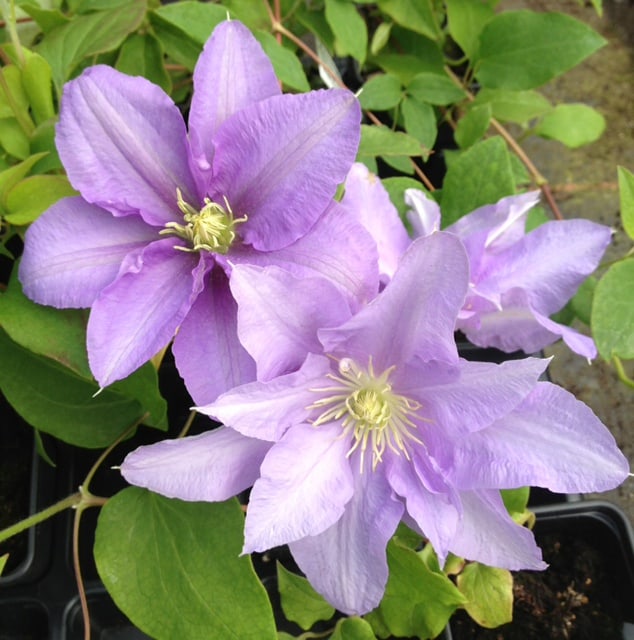
This clematis will give you beautiful flowers from the end of spring to the beginning of summer. It reaches a height of around 90cm up to 120cm and a spread between 30cm and 60cm, making it perfect for growing in small or large pots and containers.
If you are planting more than one it needs a spacing of about 60cm. It will do well in alkaline or neutral soil, chalky soil or clay soil and even sandy soil and as long as it’s well-drained it should do well. It is very showy and it will attract multiple bees and butterflies into the garden. This variety produces pale purple coloured flowers that take on a star shape and span between 12cm and 15cm. The stamen is a creamy white colour and contrast nicely with the small array of broad and overlapping purple flowers.
It is terrific for smaller gardens and in containers. Many homeowners combine it with other smaller shrubs. Once it is planted you should remove any dead or weak stems before growth can begin. You can avoid any heavy pruning with this particular variety because it is group 2 pruning so a little tidying up after flowering is all that is needed. It will provide you with a second flush of flowers later in the season if you cut back some of the stems to the next large bud or strong-side shoot. Doing this after the first flush will help you to get a second flush.
6. Clematis ‘Ooh La La’
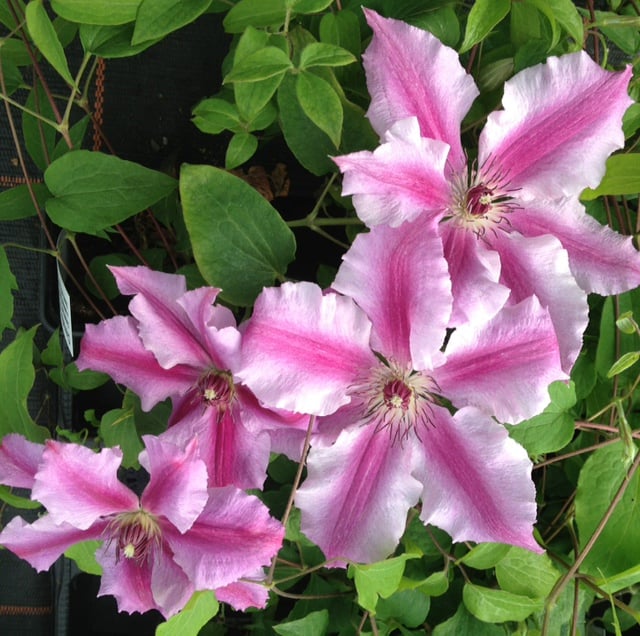
This variety gives you a break from the common purple coloured flowers and brings to the table a beautiful combination of pink. Running up the centre of each bloom you will see hot pink stripes accented by billowing light pink exteriors.
This is a compact and free-flowing plant that actually thrives in shade. That being said, growing it in shade will help you to bring more light to an otherwise dark area by way of the flowers. It can be grown on outdoor patios, decking, in containers or in a flowerbed.
It will produce flowers at the end of spring through to the end of summer. When it comes to pruning requirements you simply need to reduce the stems to about 15cm at the end of winter to encourage better growth that same season. Once it reaches maturity it will reach a height of approximately 90cm to 100cm, making it perfect for small trellis.
Last update on 2025-07-14 / Affiliate links / Images from Amazon Product Advertising API



